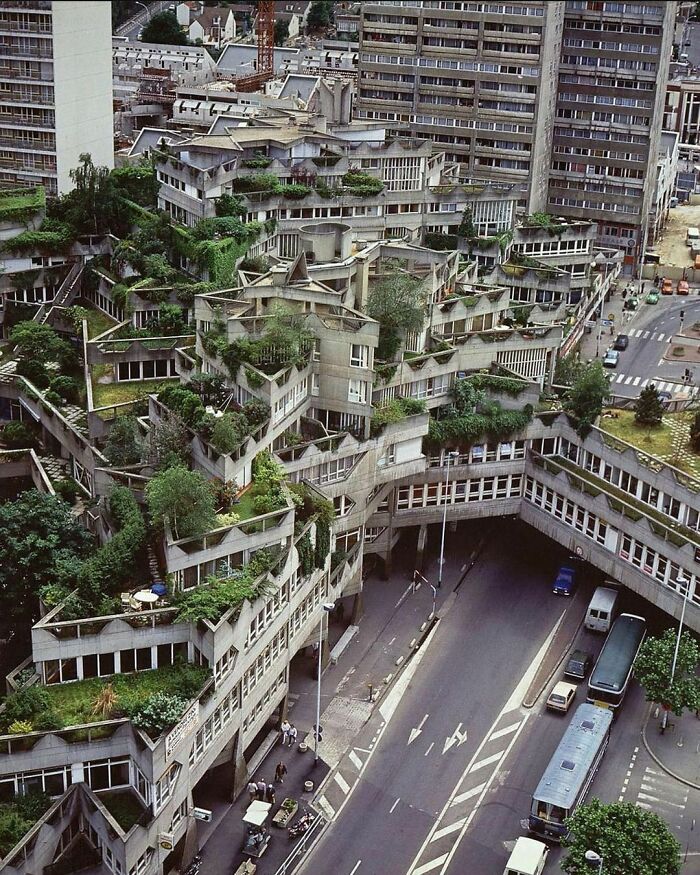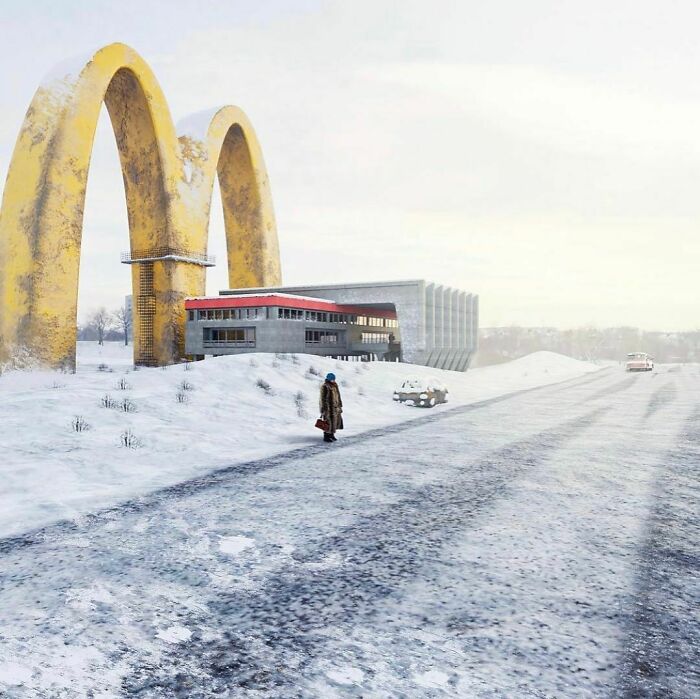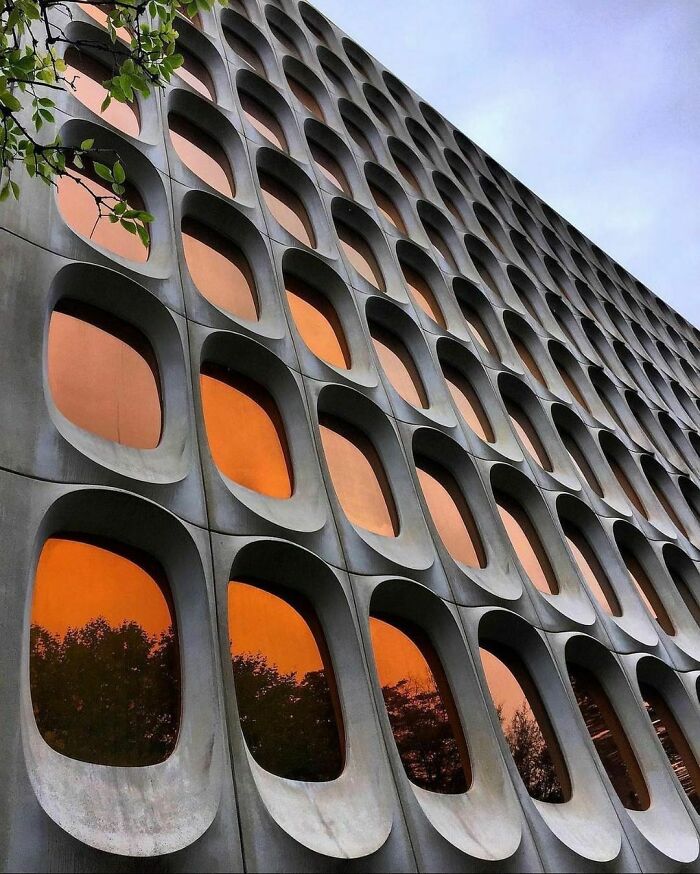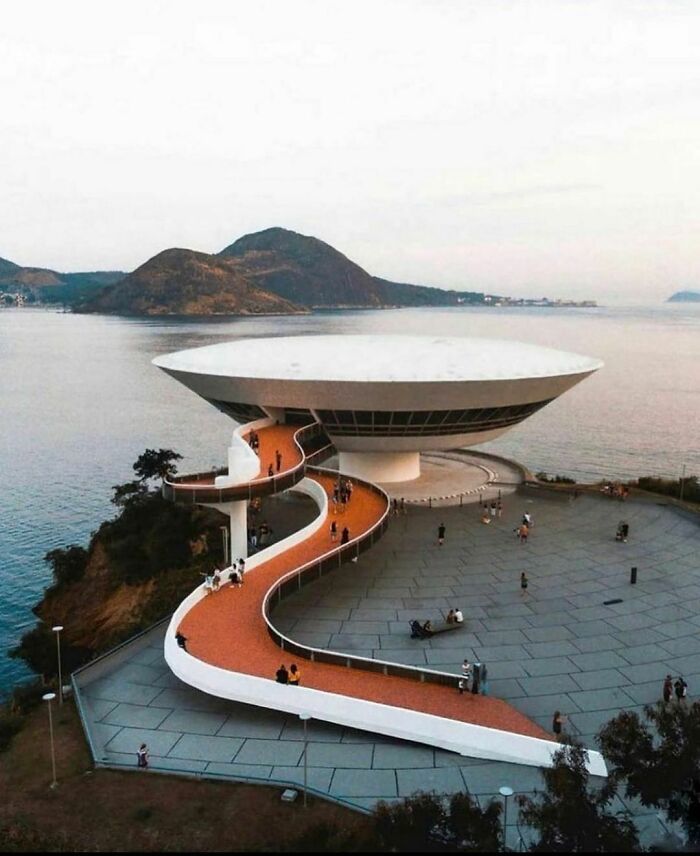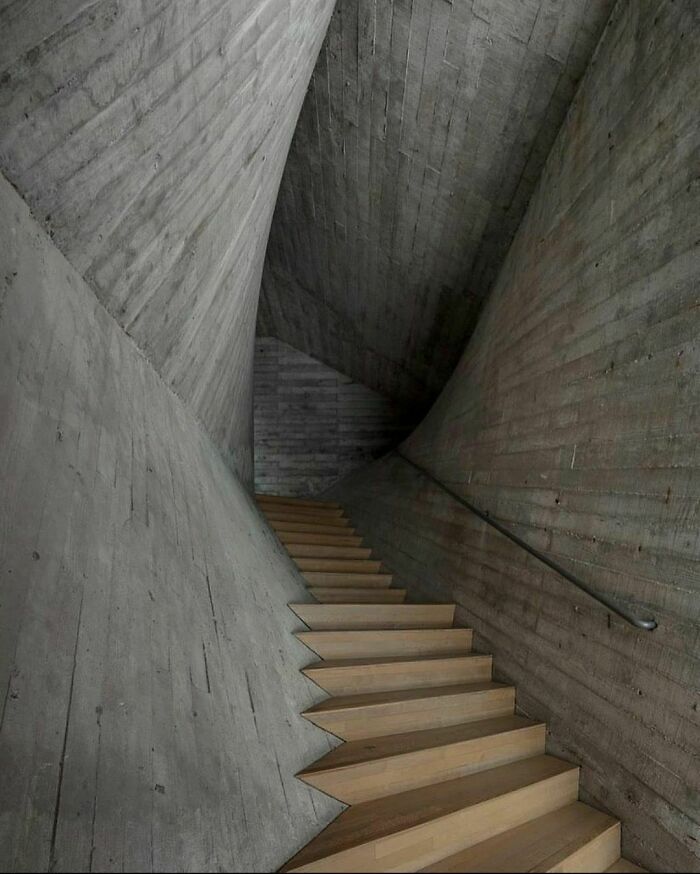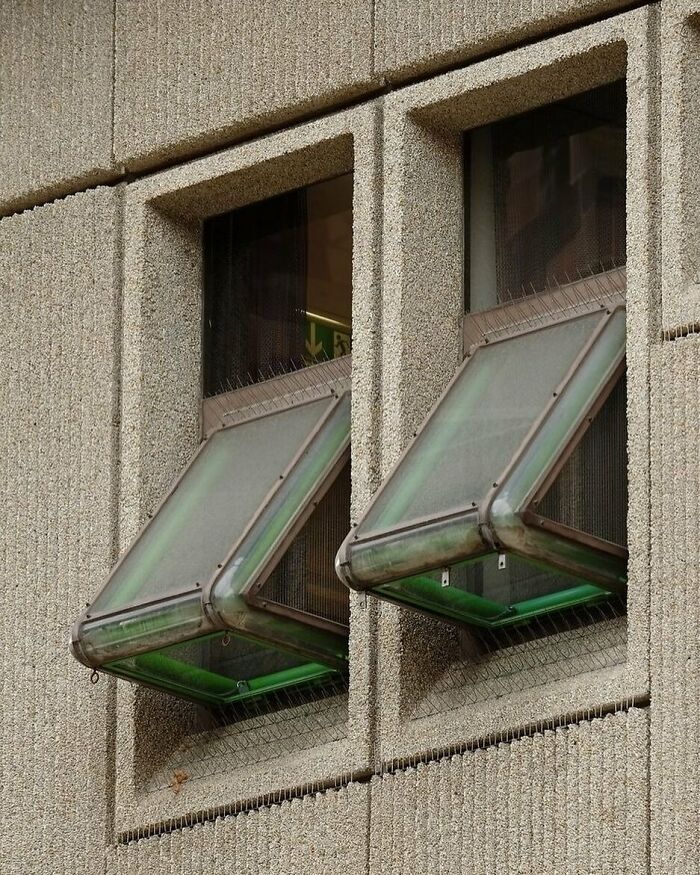
30 Incredible Examples Of Brutalism From Around The Globe, As Shared By This Instagram Page
Angular, geometric shapes, hard edges, and monolithic constructions. You are either in a Lego set or looking at an example of brutalist architecture. It’s a devise style, with some seeing it as the pinnacle of function over form, while others just think of endless, soulless commie blocks, with rotting, exposed concrete.
To convert those with less positive impressions of brutalism and showcase the best of this design, the Instagram account brutbuilds gathers some of the best examples. So scroll down, upvote your favorites, and be sure to comment on the designs that surprised you. If you want to see some other examples of brutalist design, Bored Panda has you covered, so check out our other article here.
This post may include affiliate links.
High Altitude Meteorological Observatory. . . Border Poland / Czech Republic
Anyone else thinking the upside down from stranger things?
The history chanel would probably swear that's actually an alien aircraft.
Les Etoiles
Nice greenery, could be appealing with a lick of paint. I'd rather live in one of those triangle things than in one of the nightmares behind them...
Don't lick paint. Not even if the paint gets in your tail fur.
Load More Replies...I have to know. Do you have to mow your roof or is that your upstairs neighbors problem? Also if someone is mowing the roof, can you hear that? Sleeping in Saturday morning and BOOM the lawn mower starts up, but hers is the twist! It's not a yard over, no it's on your roof!
Sorry... but thats not brutalism, that's beautiful the way they integrate the plantlife, and the angles allow so much sun and life.
Chuvash State Opera And Ballet Theater, 1985, Russia
If left to guess, I would never have imagined this building having anything to do with performance arts. Coal storage, possibly.
It turns out that some people just don't enjoy ballet.
Load More Replies...The building, the snow, gray skies and a cop. It would be hard to find a more stereotypical Russian scene. Sorry if I offended Russia...........Na, no I'm not.
Brutalism owes its popularity to Swedish architects and designers Bengt Edman and Lennart Holm. They created a house with exposed beams, exposed bricks, and hard angles. Another Swedish architect, Hans Asplund described it vividly in an article in the 1960s, which garnered a lot of attention. From there, it spread to Britain, the United States, France, and even India. In French, the style is sometimes referred to as 'béton-brut,' or ‘raw concrete.’
Careful readers may have noticed that brutalist design and architecture are used here somewhat interchangeably. While the most notable examples are buildings, often made of exposed brick and concrete, brutalism can also be seen as a general philosophy. The goal is function, first and foremost, and with that comes what some designers would describe as honesty.
Round House
Stark contrast. For me, the vast spacing between buildings and massive amounts greenery easily makes up for the brutal style buildings. Better than crowding a bunch of nice looking buildings together with room for little else, like most cities.
No, It's Moscow. There's two apt buildings like this, they were built in the 1970s. https://en.wikipedia.org/wiki/The_Round_Houses_in_Moscow
Load More Replies...The Iron Fountain . . . Polytechnic University Of Gyumri
ironically enough, this was one of the few things that survived the 1988 earthquake almost fully intact. My dad told me about this fountain being like the only thing on the campus to remain standing
Load More Replies...Judging from the utility poles behind it, not that big.
Load More Replies...haha, I thought and posted the same thing. Great minds and all.
Load More Replies...That is pretty wild. So it's a sculpture. There used to be a large academic compound here, but all the buildings were destroyed in the late 1980's by an earthquake. The fountain is what is left after the disaster.
Ponte City Apartments, Johannesburg, South Africa
DO NOT, I repeat...DO NOT GO ANYWHRE NEAR HERE!!!!!! I from Johannesburg and i wouldn't be even found dead here. This place is drug infested, run by the nigerians and ladies of the night.
Parts of Dredd were filmed not too far away actually...
Load More Replies...That looks like a prison. An example of the bad side of brutality design.
Everything should look like what it’s intended to be. A residential building doesn’t need to be adorned with all sorts of decorations to make it look more like a palace or cathedral. Similarly, the method of construction is also clearly visible. Concrete walls, exposed brick, and beams. There is nothing hiding the functional parts of the construction. To take this a step further, glass is often used in large amounts to give those on the inside and outside the freedom to see. The style might seem ugly at times, though architects would argue that this is to avoid feelings of nostalgia, which, they believed, are worse.
Brutal Shore
A quick research shows that it's the exit ramp of the Hoa Binh Dam (VietNam).
I like the term "exit ramp" for the dam spillway. Perfectly descriptive!
Load More Replies...From the late 90s with a low polygon count but nice bitmaps.
Load More Replies...Niterói Contemporary Art Museum
Agreed, Oscar Niemeyer was known for his modernist approach to architecture. This is a prime example of that philosophy, and while striking is not brutalist at all but rather a look into what "future" architecture would be like.
Load More Replies...Actually, they're talking about the crocs on the third guy from the right.
Mcbrutal Please
I'm pretty sure it's an AI generated image. (edit) : not an AI, but an art piece : https://www.globenewswire.com/en/news-release/2021/09/28/2304921/0/en/Architect-Quin-Wu-Blends-The-Soviet-Union-Centrally-Planned-Economy-With-McDonald-s.html
Load More Replies...This image infringe the copyright of Zupagrafika. The person pasted in the image is taken without permission from Zupagrafika's work, link below. The author of this render was notified. Please delete this image from the website asap. https://www.zupagrafika.com/shop/vorkuta-vorgashor-microrayon
**note to self: remember to never click on anything with this guys name on it**
Load More Replies...Doesn't look like one. They always have weird anomalies in them, even with the best AI.
Load More Replies...Often, the inner workings of a building are revealed. Pipes and conduits are on display and water tanks might be made visible to onlookers. This is in keeping with the theme of honesty. After all, most buildings and humans need running water and electricity to be functional, so why hide this obvious feature of existence? A lot of thought was given to interior space, at the visible cost of exterior decoration. The building's function is to house those inside it, not be a street decoration for onlookers.
London Aquatics Centre . . . 2014
This is the training pool that is underneath the main pool. The roof on the building was designed to resemble a whale swimming and is just supported by three points but is extremely safe.
Just goes to show that 'brutalism' doesn't have to be all that brutal.
Japan Brutalism
Pretty sure it's a retainer wall for a slope, designed to blend into the hillside so when the vegetation grows it would be invisible. Great design IMHO.
Load More Replies...This is not brutalism. It's reinforcement for a slope to prevent falling rocks, mudslides, etc. It's designed as such to allow the natural greenery to live on while keeping the area safe for those below it.
Renaissance Center
I think the name might refer to the literal meaning of renaissance, rebirth. By bringing the outdoors inside maybe the concept is to bring it back to the earth or something? Not sure if that's the intention, but that's what I was thinking
Load More Replies...Me too, Hated worked at the company, but loved being in that building.
Load More Replies...It's actually really fun to explore in this building. Lots to see and do. Or just pick a pod and chill.
GM Global HQ in Detroit... .looks nothing like this anymore. I used to be a Security Police Officer here! Detroit is the Renaissance City btw...
Last time I was there was in the 80's. I went there on my honeymoon.
Load More Replies...While these lofty ideals seem good in theory, often they break down, quite literally, in practice. Concrete has a tendency to chip and rot, leaving a number of residential buildings looking like abandoned bunkers from the second world war. The public is also often hostile to the style, as the Economist found in Britain. Often enough, when there is a campaign to demolish a building, the unit selected will be brutalist in style. People hate how the facade gets damp and overrun with moss and lichen. Steel beams suffer from rust and the style’s emphasis on uniformity makes alienates its residents.
Edificio Fiesp, São Paulo, Brazil
Looks like one of those small robots from Star Wars that drive around on imperial ships
Actually it's full of windows. images-640...60b1f7.jpg 
This actually doesn't strike me as brutalist, it looks modern and sleek. Maybe a few changes could be made but I like it!
I was thinking the big car those little desert people drive on Tatooine
Load More Replies...It does look like someone parked a '70s designed spaceship in the middle of town
Nakagin Capsule Tower . . Tokyo. . 1972
It's been dismantled last year :-/ Chris Broad from the YT channel 'Abroad in Japan' made a video about it, if you're interested. He got to film the last used pods a few months before the building was dismantled.
There is a pretty interesting yt video of this https://www.youtube.com/watch?v=vrwYUOg1bZQ&ab_channel=StewartHicks
it was a very iconic futuristic capsule hotel back in its prime and has sadly been demolished
Given the space issues, and having lived in the endless uniform apartment complexes so common there, this has personality.
Rusted Brutalism
I got you fam https://www.archdaily.com/26101/parish-church-of-santa-monica-vicens-ramos
Load More Replies...Their appearance also strikes many as heartless and monolithic. While they are functional by principle, sometimes humans feel isolated and restricted by uniformity. The choice of materials also leads to a lot of urban decay, necessitating constant preservation efforts. So some wonder if something can truly be called functional if it needs more upkeep than some 19th and 20th-century constructions.
Amphitheater Museum
Some sunblock curtains needed. Also fix that headrest while you are at it
And that is what happens when you let the couch cushion adjuster go on holiday
Brutal Man
That space manages to be visually comfortable and uncomfortable at the same time.
I'm very confused by the title. Very few of these are examples of brutalism
He looks so much like my Dad. He used to sit exactly like that. Nice memories.
Control Room
That was the first thing I thought. I think it was late 1990's or early 2000's before the last reactor at the site was taken offline.
Load More Replies...I was thinking if Andromeda Strain were filmed in Miami
Load More Replies...I think it's more like a nuclear power plant control room
Load More Replies...Hyatt Regency, San Francisco
Feels like the architect was to embarrassed to admit the blueprint was side ways. So he doubled down and had the construction company build it.
Yes. It's the only place in the neighborhood where you can't see this hotel.
Load More Replies...I’ve stayed there and it’s actually beautiful. Those are staggered balconies and the views of the bay and the Oakland bridge are breathtaking.
Disney Contemporary Hotel
This opulence can be yours for like 2 grand a night...the magic is making your money disappear.
You can certainly spend that much at Disney World, but this "resort" is fairly "midrange" among their accomodations... not that $500 a night is exactly frugal.
Load More Replies...I stayed here when I was a kid! The photo is quite old but the hotel is still around and the architecture is the same. It's actually one of the high-end on-site resorts at Disney World but I was envious of the guests in the cool, themed neighboring resorts. I do remember thinking how cool and futuristic it must have been when it was built, the modernist motif and the monorail coming right into the lobby. It had a very Tomorrowland feel consistent with the designs of cities of the future made by Disney himself. Anyways, it was still pretty cool in the mid-90s when I visited and benefits from a prime location in the heart of Magic Kingdom
As a kid we would camp at Disney Fort Wilderness. All the resorts are connected by monorail and you can use all the amenities. Even the ones you aren't staying at. I would ride the monorail to go to the arcade in the bottom of the Contemporary then the pool at the Polynesian.
Cbr Cement Company, Headquarters In Brussels
Feels like a modern design made out of their main product. Our cement is so good we built our entire company headquarters out of it.
Makes me think of the rare books library on the Yale University campus. 1536px-Bei...b-jpeg.jpg 
Concrete Acoustic Sound Mirrors . . . 1920s
Quite a few sites in Kent (UK) - they were developed as an early warning system for 'enemy aircraft' middle of WW1, and in use till the 30's.
Pre radar technology to detect aircraft coming across English channel.
Load More Replies...UFO In Bulgaria
It was meant to be a gathering/conference/ceremonial hall for the communist party, but was never really used. Then the regime fell and the whole thing was abandoned... but there are restoration efforts nowadays.
Buzludzha! - it's one of my life's ambitions to visit this place, and spend a night camped outside. Part of that ambition is to wake up looking at it, on (ideally) a beautiful bright, blue morning. The cold, I can handle.
It is being reconstructed by an international team. And a nice summer festival at the hills around it. There is a whole FBpage about it: just do a "buzludzhaproject" search
Load More Replies...It is being reconstructed by an international team. There is a whole FBpage about it: just do a "buzludzhaproject" search
1970 Lancia Stratos Zero Concept
How is that "brutalist"? It was a concept car pushing the limits of aerodynamic concept, lightning (the front lights, not shown here, are for the first time a single continuous line instead of two separate projectors) and mechanical layout. From the Stratos Zero was derived the Lancia Stratos HF, which dominated the rally scene in the early 1970s.
Very few of these are examples of brutalism. I don't think the editor knows what it means, or maybe just think it means badass
Load More Replies...Kyoto Conference Center
This looks straight out of the movie "2001: A Space Odyssey". There's 3 hours of my life I'll never get back. Totally do NOT understand why people think it's so great.
I feel like a person would get painfully bored sitting in there waiting for someone. About as appealing as sucking on cardboard.
I dunno how or why but now I know how my weird art pull is called. Brutalism is weird but so interesting
Yellow | Brutal
Great for giving directions, just look for the bright yellow stairway.
Damsel In Distress. . . Wroclaw, Manhattan
Niterói Contemporary Art Museum, Oscar Niemeyer, 1996
Good example of modernist architecture, as are most of Neimeyers buildings. Not even remotely brutalist
Ikr I see this and think of Epcot center world of tomorrow at Disney
Load More Replies...The location is Niterói, Rio de Janeiro State, Brazil
Load More Replies...My art place has a first name/it's O-S-C-A-R/my art place has a second name/it's N-I-E-M-E-Y-E-R....
😆 I was wondering if my mind was the only one that went there!
Load More Replies...World Waterpark. . . Edmonton, Alberta. . Canada
I think that they confused brutal and functional
Load More Replies...This was in the 1980s. Now that tube ride is gone and it has a zip line.
No, I was on it less than a month ago. There is also a zip line and a bungee jump since this photo but the tube ride is still very much there.
Load More Replies...1980 Trevior Fiore Citroen Karin
It was a concept car, designed to showcase new technologies in glass panel fittings (notice the flush, trimless corners). Never meant to be practical or functional, concept car take a few ideas and bring them to their extreme just to push technology further and have the designers gather lot of experience to translate into actual production vehicles. BTW, it's not brutalist either.
Citroen has always been so innovative and creative with its cars. It looks like there are only Citroen cars around this one.
Good lord, it’s a Karen car. Doesn’t surprise me, not from Citroen. Large contributor to a failed marriage along with Renault. That one was the car that broke the marriage’s camelback.
Musk wouldn't even dream of that beauty. He's compensating for never have invented anything like this breakthrough.
Load More Replies...Geisel Library. . University Of California
Avala TV Tower, Yugoslavia
Mid Century Home
This isn’t really brutalist. Just modern. Wrong materials, too decorative. It’s cool though
Bus Stop. . . Taraz, Kazakhstan
Nice for skateboarders, but it don't seem like providing much shelter for someone waiting for the bus.
Lada 4x4. . . Residential Towers . . Yerevan, Armenia
If you got one of the two apartments on the ends, on the top floor, you'd have no neighbors above or below you, or on one side. Might be nice, just don't look down when you look out your window.
Bbc Headquarters In Glasgow
Communist Headquarters In Paris
Not to be out-exceeded-quota by their East German comrades in ugly walls
Orange County Government Center . . . Goshen, NY
I’m surprised there was any orange colour left after the 70s sucked most of it out of the atmosphere.
Fab-Union Space
Lighting would be nice here. That way, you'd see the shadow of the thing lurking around the corner waiting to grab you.
José Martí Fountain. . . Cuba
Brutal Office
As long as you don't think about what is (not) beneath you
Load More Replies...Concrete Discs, Netherlands
Copied from elsewhere: It is a sculpture called "Klimwand en Schijf in Grofpuinheuvel” (which can be translated to "climbing wall and disc on rubble mount") by the Dutch artist and sculptor Frank de Wit. It seems to have been built between 1986 and 1993, and it is located in a nature park a couple km from Amsterdam.
Load More Replies...Hotel Panorama
It's when you try to take a panoramic photo and your cat ends up having way too many legs
This resort is in Slovakia. Štrbské Pleso 4020, 059 85 Vysoké Tatry, Slovakia
Interior Of Barbican Foyer. . . 1981
No, but it was meant to feel luxurious.
Load More Replies...Mercedes Benz . . . Coruña, Spain
Esqueleto Hotel. . . 1950s
Neelam Theatre
Yeah, it only looks spooky because it needs to be cleaned up, fixed up, and brightened up. The design itself I like. But I will say I’m quite spoiled in my US Harkins theaters with the leather (like?) reclining chairs. Sooo comfy. My 6 yo lays down flat when he gets bored. But this style makes me think of a school auditorium.
Load More Replies...La Tulipe . . . Geneva Switzerland
Lugdunum Museum
Lugdunum is the roman name of the city of Lyon (France) (Allez l'Olympique Lyonnais 😁) and the Lugdunum museum is the archeological museum of Lyon
Load More Replies...Druzhba Sanatorium . . . Crimea. . 1985
Brutal Slide
Can anyone read, and translate, the red sign? I'm thinking it's just something about not sliding down
Probably "no skating" since that was my very first thought.
Load More Replies...I don't know about sliding, but it is definitely a beautiful piece of sculpture.
Restoration
Breuninger Department Store
Probably pigeon spikes, so that birds don't try to nest on it.
Load More Replies...Constantin Brodzki 1970
Sc Johnson Headquarters
I’m pretty sure they aren’t Brutalist, either.
Load More Replies...Swimming Pool, Der Spiegel Building. . . Hamburg . . 1969
House T. . . Tokyo
Cold Comforts. . . Antarctic Research Base
Monument Of The Fallen Soldiers. . Serbia
Royal National Theatre . . . London
So has no one invented an anti mold treatment for concrete? Mold seems to be the major thing making these concrete structures so gross.
It’s not mould. This gets cleaned yearly. The lines are how the concrete was cast as this was built for the Festival of Britain in 1951.
Load More Replies...The National Library. . . Minsk, Belarus
Except it's just the one building, not a serie of them. This is photoshopped.
I wanted to go and check this out when I was in Belarus but my wife refuses to go inside of it because the government taxed them to pay for it.
There is only one of these pods. https://www.google.com/maps/place/National+Library+of+Republic+of+Belarus/@53.9307008,27.6444014,666a,35y,323.28h,45.27t/data=!3m1!1e3!4m6!3m5!1s0x46dbcedd83dd1587:0xde7f1c4f89d5e8b2!8m2!3d53.9314711!4d27.6461562!16zL20vMGIxMXQx
Paul Rudolph’s Lower Manhattan Expressway. . . 1967
Disney’s Contemporary Resort. . . Orlando. . USA
Chiesa Di San Giovanni Battista
Mario Botta's Church of St. John in Mogno, Switzerland. Not brutalist in any way, uses lot of local stone and has a peculiar blend of modern style and ancient materials and details (such as the portal shown, that reminds of the Tuscan Baroque). It was built in 1996 on the site of a XVI century chapel that was destroyed -along with part of the town- by an avalanche on 25th of April 1986. The church has the same volume and integrates some statues and the two bells of the old one.
Žižkov Television Tower, Prague, Czech Republic
People should see the full size, with the crawling babies on it ...
Brutal UFO Landed
Content filler in a copy and paste world. Original ideas and effort are gone
Load More Replies...Bolwoningen, S-Hertogenbosch. . . Netherlands
Brutal Orange
Claire T. Carney Library At Umass Dartmouth
The library still stands but the architecture extends beyond this one building. The architecture is mirrored in the exterior and interior design of the entire campus.
Load More Replies...My father taught here for a few decades, I was hoping to see this place on the list. The campus is full of crazy textures and odd angles.
Communist Headquarters Paris
Salgótarján . . . Hungary
Brutalist House
When they say house I wish they would show us the house. They just show us a wall here.
New Sherp Just Landed In The States
I wouldn't say that it's impractical, probably has lots of practical uses.
Oh great another stupid, ugly, grotesque, impractical, dangerous car.
It's designed for use in remote swampy areas and has a maximum speed of 25mph. Relax a little.
Load More Replies...If they say you compensate something with a Hummer, what would they say for this :P
I can't wait to see those in the pick up line at elementary school
Model M400 Helicoid Spiral Staircase
As a kid in the 60s a friend lived in a house with open tread stairs and it scared the s### out of me. I avoided going up, and more especially down, stairs whenever possible.
They would be so cool, if you have good balance and don't drink beer 🍻
The Most Brutal Seat Reserved. . . . Japan
Megatron Mcdonald’s, Cambridgeshire, England
House In Kikuzaka
Citroën Karin, Trevor Fiore
The Oscar Niemeyer Step . . . Paris
Exposec concrete doesn't equal brutalism - can be quite a sensual material to design with. But the majority of these examples don't stand for brutalism. At all.
came down here to point that out. Most of the interiors shown are Mid Century Modern, one of them was designed by Frank Lloyd Wright.
Load More Replies...Yeah, apparently still going strong. https://en.wikipedia.org/wiki/Habitat_67
Load More Replies...I got too irritated by all the ones that weren't actually brutalist. I couldn't finish the list even though the buildings were neat.
they could have changed the ones that are not even close to brutalism for some icons like the Barbican, the Trellick or the Alexandra, all in London.
Not just concrete can make stg. brutalist. This is the interior of a church in Budapest, Hungary from 1983. smugmugMaj...395cb5.jpg 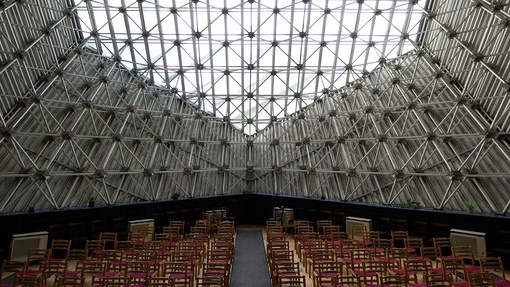
Exposec concrete doesn't equal brutalism - can be quite a sensual material to design with. But the majority of these examples don't stand for brutalism. At all.
came down here to point that out. Most of the interiors shown are Mid Century Modern, one of them was designed by Frank Lloyd Wright.
Load More Replies...Yeah, apparently still going strong. https://en.wikipedia.org/wiki/Habitat_67
Load More Replies...I got too irritated by all the ones that weren't actually brutalist. I couldn't finish the list even though the buildings were neat.
they could have changed the ones that are not even close to brutalism for some icons like the Barbican, the Trellick or the Alexandra, all in London.
Not just concrete can make stg. brutalist. This is the interior of a church in Budapest, Hungary from 1983. smugmugMaj...395cb5.jpg 

 Dark Mode
Dark Mode 

 No fees, cancel anytime
No fees, cancel anytime 








